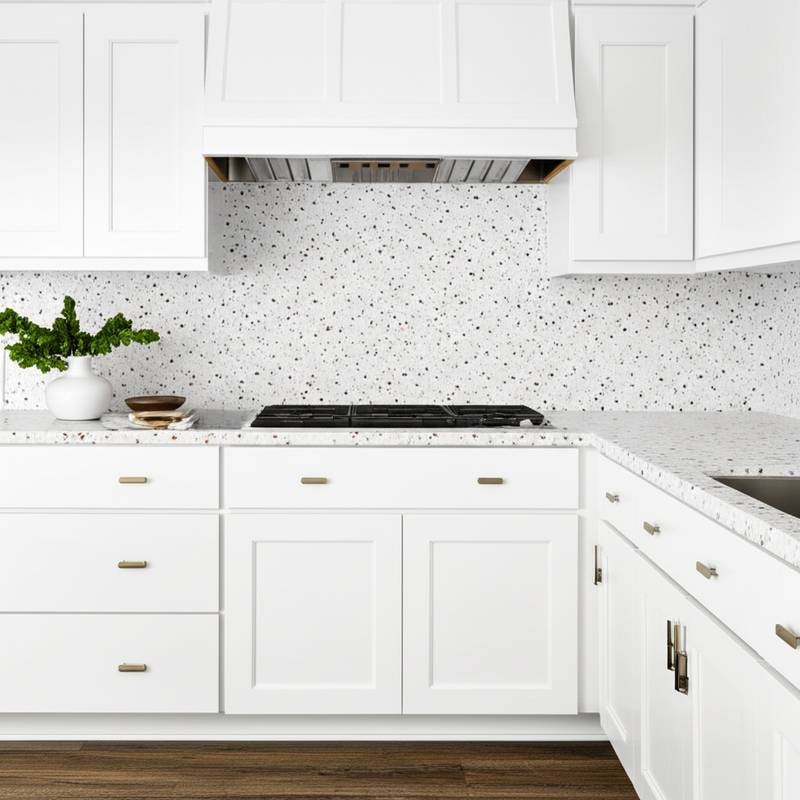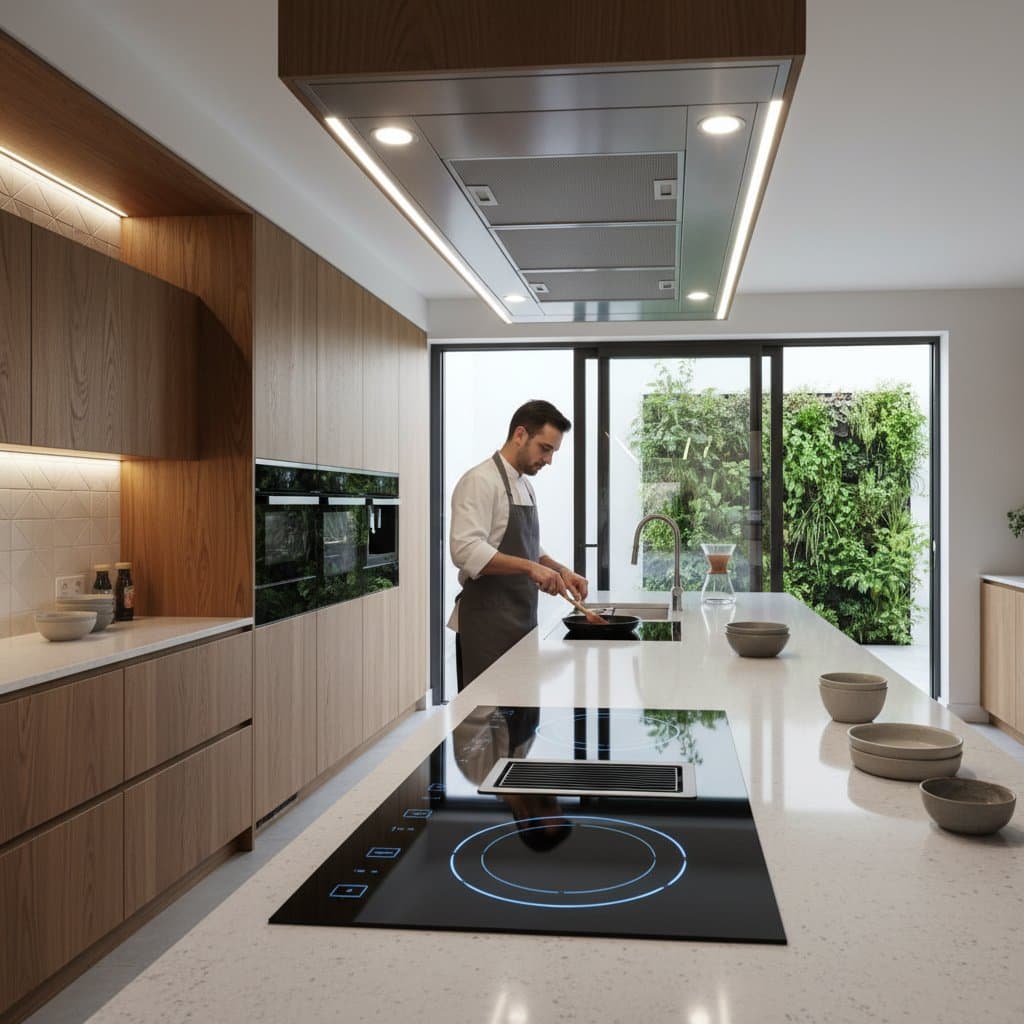Terrazzo Revival: Bold Backsplashes Under $500 for 2025
Homeowners often seek ways to update their kitchens without committing to extensive renovations. A worn or outdated backsplash can diminish the space's appeal, yet replacing it need not require significant expense. Terrazzo, the distinctive composite with its embedded chips of marble, quartz, glass, or aggregates in cement or resin, offers a solution. This material, historically prominent in mid-century architecture, now reemerges in contemporary designs, and versions suitable for budgets under $500 make it attainable.
This guide examines terrazzo's suitability for backsplashes, evaluates budget-friendly material variants, and provides installation protocols. Readers gain insights into material specifications, expense projections, and required efforts to achieve a sophisticated, resilient aesthetic economically.
Why Terrazzo Suits Modern Kitchens
Terrazzo consists of aggregates bound by cement or resin, yielding a surface rich in texture and pattern. Advances in production have rendered it lighter, more vibrant, and simpler to apply than traditional forms. The result blends nostalgic charm with sleek modernity, ideal for kitchens, bathrooms, and feature walls.
This material surpasses basic tiles or laminates by introducing depth and character. It harmonizes with wooden elements, stainless steel appliances, or subdued cabinet finishes. Options range from subtle earth tones to vibrant aggregates, positioning the backsplash as a focal point. Beyond aesthetics, terrazzo withstands daily use, resisting stains and impacts effectively.
Affordability drives its resurgence. While authentic poured terrazzo or bespoke tiles once demanded high costs, resin composites and adhesive-backed alternatives now enable DIY implementation at reduced prices.
Addressing Budget Constraints for Premium Aesthetics
A common misconception positions terrazzo as an extravagant choice. Conventional installations, including poured surfaces or custom tiles, frequently exceed $1,500 in materials alone. Professional labor can elevate totals substantially, rendering it impractical for modest kitchens.
The objective involves replicating terrazzo's essence through cost-effective substitutes. This requires assessing material properties, weighing installation approaches, and determining between self-directed or expert execution. Strategic selection keeps expenditures below $500, encompassing adhesives and sealants.
Budget-Friendly Terrazzo Alternatives
Consider these options, categorized by expense, visual fidelity, and installation complexity.
1. Peel-and-Stick Terrazzo Panels
- Cost: $2 to $6 per square foot
- Difficulty: Easy
- Best for: Renters or rapid renovations
These panels utilize flexible vinyl or PVC substrates imprinted with terrazzo motifs. Certain products incorporate embossed textures to simulate stone granularity. Installation involves scissor cuts, application over prepared drywall or tiles, and damage-free removal.
Durability limitations arise near moisture or heat, necessitating proper sealing. Select kitchen-grade variants and apply a protective clear coat. For a 25-square-foot backsplash, anticipate $60 to $150 in total costs.
2. Terrazzo-Patterned Laminate Sheets
- Cost: $3 to $8 per square foot
- Difficulty: Moderate
- Best for: Users adept at cutting and bonding large formats
Laminate provides robustness and straightforward maintenance. Panels adhere to plywood backings or extant tiles using robust contact cement. A jigsaw facilitates precise shaping, yielding seamless appearances superior to peel-and-stick methods.
Budget $200 to $300 for supplies. Alignment of joints and edge finishing demand attention; silicone caulking at seams averts moisture intrusion.
3. Ceramic or Porcelain Tiles Mimicking Terrazzo
- Cost: $4 to $10 per square foot
- Difficulty: Moderate to advanced
- Best for: Lasting enhancements or property value boosts
Tiles deliver authentic tactile and visual depth. Porcelain or ceramic variants feature printed terrazzo designs in varied sheens. They endure heat and water, suiting placements adjacent to ranges and sinks.
Essential tools include adhesive, spacers, grout, and a cutter. Experienced individuals find this a fulfilling project. Professional assistance for minor areas adds $200 to $300 in labor, yet economical tiles maintain the $500 threshold.
4. Authentic Terrazzo Remnants
- Cost: $10 to $20 per square foot for remnants
- Difficulty: Advanced; professional aid advised
- Best for: Targeted accents or value-driven luxury
Suppliers offer surplus slabs from major installations at discounted rates. Compact remnants suit backsplash dimensions. Fabrication demands a wet saw and protective equipment due to weight and hardness.
Engage specialists for cutting if unequipped. Integrate remnants selectively, pairing with painted sections or borders, to control costs while amplifying impact behind key fixtures.
DIY Installation Protocol for Terrazzo Backsplashes
Follow this sequence to execute the project methodically.
Step 1: Measure and Design
Determine dimensions from countertop to upper cabinets. Calculate square footage by multiplying length and height, incorporating 10 percent extra for cuts. Diagram the layout, accounting for electrical outlets and angles.
Step 2: Select Materials
Align choices with proficiency and environmental factors. Peel-and-stick suits low-moisture zones; tiles or laminates excel in demanding areas.
Step 3: Surface Preparation
Degrease and dust the wall completely. Patch imperfections and abrade for smoothness. Over existing tiles, lightly score to enhance bonding.
Step 4: Precise Application
With peel-and-stick, expose adhesive incrementally and secure using a roller. For laminates, distribute cement uniformly and eliminate bubbles. Tiles require mortar application, spacer placement, and leveling.
Step 5: Finishing Touches
Grout tiles post-setting and seal upon curing. Apply silicone at edges and junctions for waterproofing. Clean thoroughly and verify stability.
Step 6: Ongoing Care
Use gentle soap solutions for cleaning; eschew abrasives. Sealants mitigate oil and spill effects, preserving vibrancy.
Projected Expenses and Timeline
Standard backsplashes span 25 to 30 square feet. Breakdowns for sub-$500 projects include:
- Peel-and-stick panels: $100 to $200
- Laminate sheets: $200 to $300
- Terrazzo-look tiles (DIY): $300 to $450
- Remnants: $400 to $500
Allocate $50 additional for sundries like tools if needed. Completion typically spans a weekend, factoring in curing periods.
Safety Protocols and Compliance
Kitchen modifications warrant caution. Verify non-combustible ratings for areas near gas appliances. Employ heat-tolerant materials accordingly. De-energize circuits before outlet work.
Don protective gear during cutting operations. Ensure ventilation when handling volatile compounds. Delegate complex tasks involving electricity, plumbing, or heavy slabs to qualified professionals.
Styling Strategies for Terrazzo Backsplashes
Maximize impact through thoughtful integration.
-
Neutral Tones with Wood: Opt for light aggregates in whites and beiges to complement organic cabinetry.
-
Dramatic Pairing: Dark terrazzo against pale bases creates contemporary drama.
-
Vibrant Accents: Infuse blues or corals for subtle energy in neutral schemes.
-
Hybrid Approaches: Limit terrazzo to sink zones, extending painted surfaces elsewhere.
Extend patterns slightly above open shelves for unified visuals.
Long-Term Performance and Upkeep
Quality terrazzo simulants endure with routine care. Inspect peel-and-stick edges quarterly, resealing as required. For tiles or genuine pieces, refresh grout seals biennially to avert discoloration.
Implementing Your Terrazzo Upgrade
Terrazzo enhances kitchen vitality accessibly when matched to capabilities and finances. Commence with a modest panel at a focal point to gauge suitability before broader application.
Precise execution yields a textured, personalized space that transcends trends, delivering lasting satisfaction.










